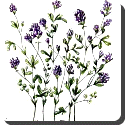 Alfalfa — Alfalfa (Medicago sativa), also known as lucerne, purple medic and trefoil is a perennial flowering plant cultivated as an important forage crop. In the UK, where it is not widely grown, it is known as lucerne.
Alfalfa — Alfalfa (Medicago sativa), also known as lucerne, purple medic and trefoil is a perennial flowering plant cultivated as an important forage crop. In the UK, where it is not widely grown, it is known as lucerne.
Alfalfa lives from three to twelve years, depending on variety and climate. It is a cool season perennial legume, sometimes growing to a height of 1 meter. It resembles clover with clusters of small purple flowers. It also has a deep root system sometimes stretching to 4.5 metres. This makes it very resilient, especially to droughts. It has a tetraploid genome. The plant exhibits autotoxicity, which means that it is difficult for alfalfa seed to grow in existing stands of alfalfa. Therefore, it is recommended that alfalfa fields be rotated with other species (e.g. corn, wheat) before reseeding.
Like other legumes, its root nodules contain bacteria, Sinorhizobium meliloti, with the ability to fix nitrogen, producing a high-protein feed regardless of available nitrogen in the soil. Its nitrogen-fixing abilities (which increases soil nitrogen) and use as animal feed greatly improved agricultural efficiency.
It is widely grown throughout the world as forage for cattle, and is most often harvested as hay, but can be made into silage, grazed, or fed as greenchop. Alfalfa has the highest feeding value of all common hay crops, being used less frequently as pasture. When grown on soils where it is well-adapted, alfalfa is the highest yielding forage plant.
Alfalfa is one of the most important legumes used in agriculture. The US is the largest alfalfa producer in the world, but considerable acreage is found in Argentina (primarily grazed), Australia, South Africa, and the Middle East. The leading alfalfa growing states (within the U.S.A.) are California, South Dakota, and Wisconsin. The upper Midwestern states account for about 50% of US production, the North-eastern states 10%, the Western states 40% and the Southeastern states almost none. Alfalfa has a wide range of adaptation and can be grown from very cold northern plains to high mountain valleys, from rich temperate agricultural regions to Mediterranean climates and searing hot deserts.
Its primary use is for dairy production, followed by beef, horses, sheep, and goats, but it is sometimes used for human consumption. Alfalfa sprouts are used as a salad ingredient. Tender shoots are eaten in some places as a leaf vegetable. Human consumption of older plant parts is limited primarily by very high fiber content. Dehydrated alfalfa leaf is commercially available as a dietary supplement in several forms, such as tablets, powders and tea. Alfalfa is believed to be a galactagogue.
 Kids Portal For Parents India Kids Network
Kids Portal For Parents India Kids Network






